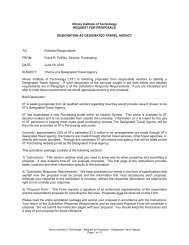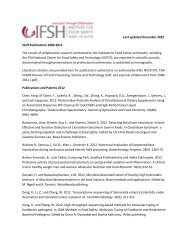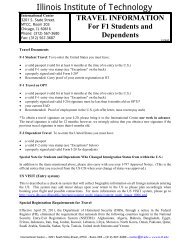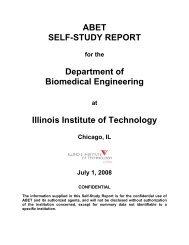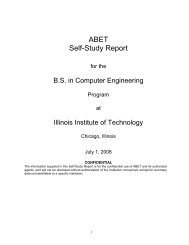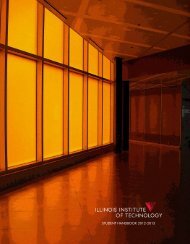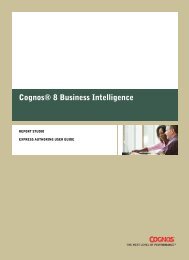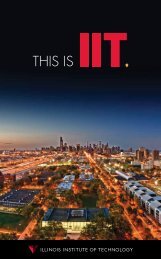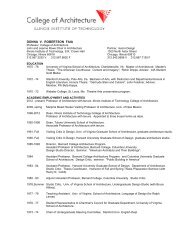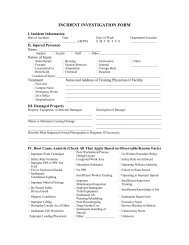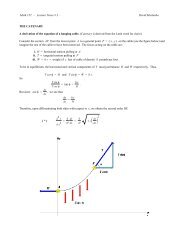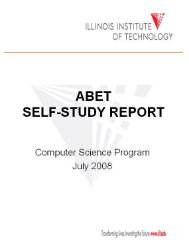Copyright & Disclaimer Information - Illinois Institute of Technology
Copyright & Disclaimer Information - Illinois Institute of Technology
Copyright & Disclaimer Information - Illinois Institute of Technology
You also want an ePaper? Increase the reach of your titles
YUMPU automatically turns print PDFs into web optimized ePapers that Google loves.
204<br />
Course Descriptions<br />
riage. Prerequisite: A 100-level<br />
humanities course. (3-0-3) (H) (C)<br />
PHIL 380<br />
Topics in Philosophy<br />
An investigation into a topic <strong>of</strong> current<br />
interest in philosophy, which<br />
will be announced by the instructor<br />
when the course is scheduled.<br />
Prerequisite: A 100-level humanities<br />
course. (3-0-3) (H) (C)<br />
PHIL 490, 491<br />
Independent Study<br />
Supervised individual research for<br />
advanced students. Prerequisite:<br />
Consent <strong>of</strong> the department. (Credit:<br />
Variable.) (H) (C)<br />
Physics<br />
PHYS 100<br />
Introduction to the Pr<strong>of</strong>ession<br />
Introduction to the physical sciences,<br />
scientific method, computing tools<br />
and interrelations <strong>of</strong> physical sciences<br />
with chemistry, biology and other pr<strong>of</strong>essions.<br />
(2-0-2) (C)<br />
PHYS 120<br />
Astronomy<br />
A descriptive survey <strong>of</strong> observational<br />
astronomy, the solar system, stellar<br />
evolution, pulsars, black holes, galaxies,<br />
quasars and the origin and fate<br />
<strong>of</strong> the universe. (3-0-3)<br />
PHYS 123<br />
General Physics I: Mechanics<br />
Vectors and motion in one, two and<br />
three dimensions. Newton’s Laws.<br />
Particle dynamics, work and energy.<br />
Conservation laws and collisions.<br />
Rotational kinematics and dynamics,<br />
angular momentum and equilibrium <strong>of</strong><br />
rigid bodies. Gravitation, oscillations<br />
and waves. Corequisite: MATH 149 or<br />
MATH 151. (3-3-4) (C)<br />
PHYS 200<br />
Basic Physics for Architects<br />
This class is a onesemester course<br />
primarily for students <strong>of</strong> architecture.<br />
The course will address the<br />
basic physical principles and concepts<br />
associated with structures and<br />
buildings. Although quantitative at<br />
times, the course will stress concep-<br />
<strong>Copyright</strong> & <strong>Disclaimer</strong> <strong>Information</strong>: <strong>Copyright</strong> © 1994, 1995, 1996, 1997, 1998, 1999, 2000, 2001, 2002, 2003, 2004, 2005, 2006, 2007. CollegeSource®, Inc. and Career Guidance Foundation. CollegeSource® digital catalogs are derivative works owned and copyrighted by CollegeSource®, Inc. and Career Guidance Foundation. Catalog content is owned and copyrighted by the appropriate school. While CollegeSource®, Inc. and Career Guidance Foundation provides information as a service to the public, copyright is retained on all digital catalogs.<br />
<strong>Copyright</strong> & <strong>Disclaimer</strong> <strong>Information</strong>: <strong>Copyright</strong> © 1994, 1995, 1996, 1997, 1998, 1999, 2000, 2001, 2002, 2003, 2004, 2005, 2006, 2007. CollegeSource®, Inc. and Career Guidance Foundation. CollegeSource® digital catalogs are derivative works owned and copyrighted by CollegeSource®, Inc. and Career Guidance Foundation. Catalog content is owned and copyrighted by the appropriate school. While CollegeSource®, Inc. and Career Guidance Foundation provides information as a service to the public, copyright is retained on all digital catalogs.<br />
tual understanding and practical<br />
applications. Hands-on exercises will<br />
be conducted both in class, and out <strong>of</strong><br />
class. Extensive web-based materials<br />
will be available in lieu <strong>of</strong> a textbook.<br />
(4-0-4)<br />
PHYS 211, 212<br />
Basic Physics I, II<br />
Intended to give students in the liberal<br />
arts, architecture and design an<br />
understanding <strong>of</strong> the basic principles<br />
<strong>of</strong> physics and an appreciation <strong>of</strong> how<br />
the results <strong>of</strong> physics influence contemporary<br />
society. Prerequisite:<br />
MATH 122. These courses do not<br />
satisfy graduation requirements in<br />
any engineering or physical science<br />
program. (3-0-3); (3-0-3)<br />
PHYS 221<br />
General Physics II: Electromagnetism and Optics<br />
Simple harmonic motion, oscillations<br />
and waves. Charge, electric field,<br />
Gauss’ Law and potential. Capacitance<br />
resistance, simple AC and DC circuits.<br />
Magnetic fields, Ampere’s Law,<br />
Faraday’s Law and induction.<br />
Maxwell’s equations and electromagnetic<br />
waves. Prerequisite: PHYS 123.<br />
Corequisite: MATH 152. (3-3-4) (C)<br />
PHYS 223<br />
General Physics III: Thermal and Modern Physics<br />
Temperature, first and second laws <strong>of</strong><br />
thermodynamics, kinetic theory and<br />
entropy. Geometric and physical<br />
optics. Special relativity. Light and<br />
quantum physics, wave nature <strong>of</strong> matter,<br />
structure <strong>of</strong> the hydrogen atom.<br />
Atomic physics, nuclear physics and<br />
particle physics. Prerequisite: PHYS<br />
221. Corequisite: MATH 251 or<br />
MATH 252. (3-3-4)<br />
PHYS 224<br />
General Physics III Lecture:<br />
Thermal and Modern Physics<br />
Temperature, first and second laws<br />
<strong>of</strong> thermodynamics, kinetic theory<br />
and entropy. Gratings and spectra,<br />
polarization. Light and quantum<br />
physics, wave nature <strong>of</strong> matter,<br />
structure <strong>of</strong> the hydrogen atom.<br />
Atomic physics, electrical conduction<br />
in solids, nuclear physics and particle<br />
physics. Prerequisite: PHYS 221.<br />
Corequisite: MATH 251 or MATH<br />
252. (3-0-3)<br />
IIT Undergraduate Bulletin 2006–2008<br />
PHYS 240<br />
Computational Science<br />
This course provides an overview <strong>of</strong><br />
introductory general physics in a<br />
computer laboratory setting. Euler-<br />
Newton method for solving differential<br />
equations, the trapezoidal rule<br />
for numerical quadrature and simple<br />
applications <strong>of</strong> random number generators.<br />
Computational projects<br />
include the study <strong>of</strong> periodic and<br />
chaotic motion, the motion <strong>of</strong> falling<br />
bodies and projectiles with air resistance,<br />
conservation <strong>of</strong> energy in<br />
mechanical and electrical systems,<br />
satellite motion, using random numbers<br />
to simulate radioactivity, the<br />
Monte Carlo method, and classical<br />
physical models for the hydrogen<br />
molecule and the helium atom.<br />
Prerequisite: PHYS 223 or permission<br />
<strong>of</strong> the department. (2-3-3) (C)<br />
PHYS 300<br />
Instrumentation Laboratory<br />
Basic electronic skills for scientific<br />
research. Electrical measurements,<br />
basic circuit analysis, diode and transistor<br />
circuits. Transistor and integrated<br />
amplifiers, filters and power<br />
circuits. Basics <strong>of</strong> digital circuits,<br />
including Boolean algebra and design<br />
<strong>of</strong> logic circuits. Prerequisite: PHYS<br />
221. (2-3-3) (C)<br />
PHYS 304<br />
Kinetic Theory and Thermodynamics<br />
The notion <strong>of</strong> phenomenological characterization:<br />
pressure, volume, temperature,<br />
etc. The first and second<br />
laws <strong>of</strong> thermodynamics. Transport<br />
phenomena; thermodynamic functions<br />
and their applications. Introduction<br />
to Maxwell-Boltzmann statistics.<br />
Prerequisite: PHYS 223. (3-0-3)<br />
PHYS 308, 309<br />
Classical Mechanics I, II<br />
Newton’s Laws, one-dimensional<br />
motion, vector methods, kinematics,<br />
dynamics, conservation laws and the<br />
Kepler problem. Collisions, systems<br />
<strong>of</strong> particles, and rigid-body motion.<br />
Approximation techniques;<br />
Lagrangian and Hamiltonian formulations<br />
<strong>of</strong> classical mechanics; small<br />
oscillations. Prerequisites: PHYS<br />
223, MATH 252. (3-0-3); (3-0-3)



